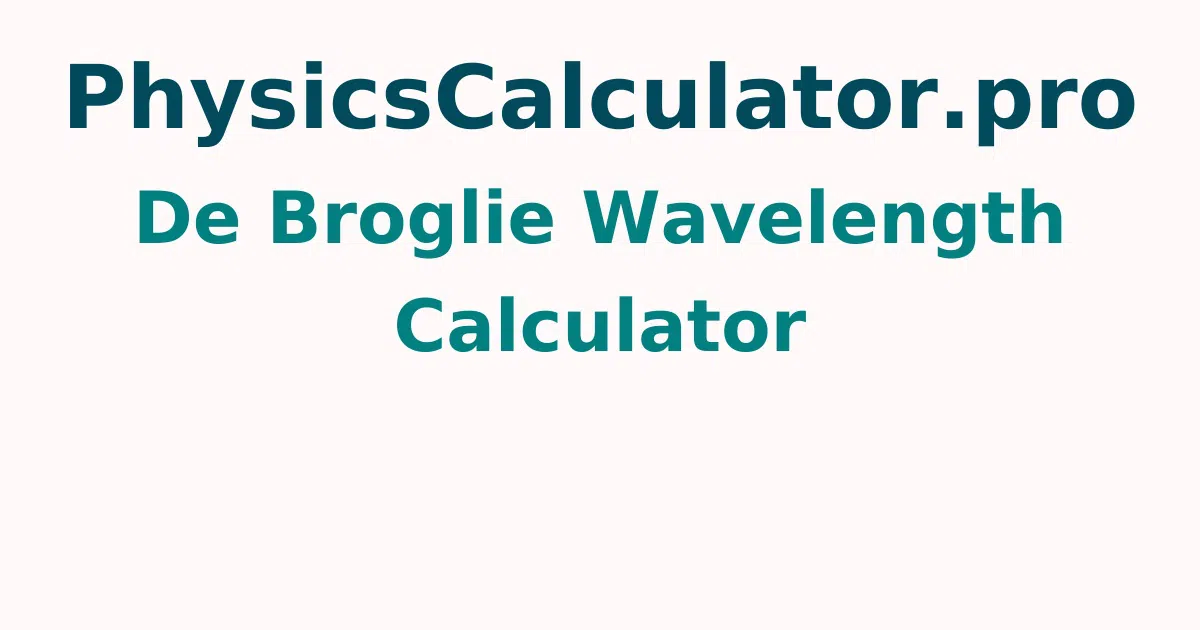De Broglie Wavelength Calculator
The de Broglie Wavelength Calculator is a handy tool for quickly calculating the wavelength of electrons. You only need to input the electron's velocity and mass to obtain the momentum and wavelength values.
What Does De Broglie Wavelength Mean?
The De Broglie wavelength is described in physics as the wavelength at which an object's mass and momentum are related. It's worth noting that the object force and De Broglie wavelength are inversely related. This equation depicts the link between a body's wave and particle nature. The de Broglie wavelength formula is expressed mathematically as λ = h/p (or) λ = h/mv
- Where, λ = wavelength
- p = momentum of the photon
- h = Planck’s constant = 6.626 × 10^-34 Js
How to Calculate the Wavelength of De Broglie?
These are the simple steps for calculating the electron wavelength. Check the result using these principles as a guide.
- Step 1: Let's look at the velocity and mass of electrons.
- Step 2: Multiply the electrons' mass and velocity.
- Step 3: To find the wavelength, divide the constant by the product.
- Step 4: To find the momentum, divide the constant by the wavelength obtained.
How to Use the De Broglie Wavelength Calculator?
The following is the procedure of how you use the De Broglie wavelength calculator
- Step 1: In the input area, enter the photon energy and x for the unknown value.
- Step 2: To calculate the wavelength, click the "Calculate x" button.
- Step 3: Finally, the De Broglie wavelength will be used to display the unknown value in the output field.
De Broglie Wavelength Examples
Question 1: The electron’s de Broglie wavelength is 0.28 nm. The mass of an electron particle is 7.36 x 10^-31 kg. Calculate the electron's velocity.
Solution:
Given
Mass of the electron m = 7.36 x 10^-31 kg
Wavelength λ = 0.28 nm
de Broglie equation is λ = h/mv
v = h/mλ
v = 6.63 x 10^-34 /(7.36 x 10^-31 x 0.28)
= 6.63 x 10^-34/2.06 x 10^-31
= 3.218 x 10^-3
Hence, the velocity of the electron is 3.218 x 10^-3 m/s
Question 2: What is an electron's wavelength if it moves at 4.34 x 10^6 m/sec?
Solution:
Given:
Mass of electron = 9.11 x 10^-31 kg
Velocity of electron v = 4.34 x 10^6 m/s
Planck's constant h = 6.626 x 10^-34 Js
de Broglie equation λ = h/mv
λ = 6.626 x 10^-34/(9.11 x 10^-31 x 4.34 x 10^6)
= 6.626 x 10^-34/3.95 x 10^-24
= 1.67 x 10^-10 m
= 1.67 Å
Hence, the wavelength of the moving electron is 1.67 Å.
FAQs on De Broglie Wavelength
1. How do you find out wavelength from momentum?
For matter waves, the ratio between momentum and wavelength is p = h/λ , while the link between energy and frequency is E = hf. The de Broglie wavelength is equal to λ = h/p, and the de Broglie relations are equal to λ = h/p and f = E/h, respectively.
2. What exactly is the De Broglie Connection?
The De-Broglie connection connects the momentum of a body to its wavelength. It's written λ=ph, where ph is the de-Broglie wavelength. The planks constant is h.
3. What is the De Broglie Equation and how do you get it?
hmomentum = λ = hmv, where 'h' is the Plank constant. The de-Broglie equation relates a particle's momentum to its wavelength, and the wavelength derived using this connection is known as the de-Broglie wavelength.
4. Is zero acceleration always constant?
The term zero acceleration refers to no change in velocity, i.e. the body is moving at the same speed.
